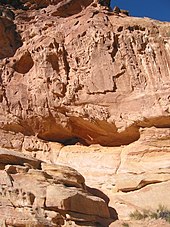
Back Фрэманцкая культура Byelorussian Cultura Fremont Catalan Fremont-Kultur German Cultura de Fremont Spanish Fremontin kulttuuri Finnish Culture Fremont French תרבות פרימונט HE Cultura di Fremont Italian Fremonto kultūra Lithuanian Fremontcultuur Dutch

The Fremont culture or Fremont people is a pre-Columbian archaeological culture which received its name from the Fremont River in the U.S. state of Utah, where the culture's sites were discovered by local indigenous peoples like the Navajo and Ute. In Navajo culture, the pictographs are credited to people who lived before the flood. The Fremont River itself is named for John Charles Frémont, an American explorer. It inhabited sites in what is now Utah and parts of Nevada, Idaho, Wyoming and Colorado from AD 1 to 1301 (2,000–700 years ago[1]). It was adjacent to, roughly contemporaneous with, but distinctly different from the Ancestral Pueblo peoples located to their south.

- ^ Janetski and Talbot 2014 in Archaeology in the Great Basin and Southwest p. 118.